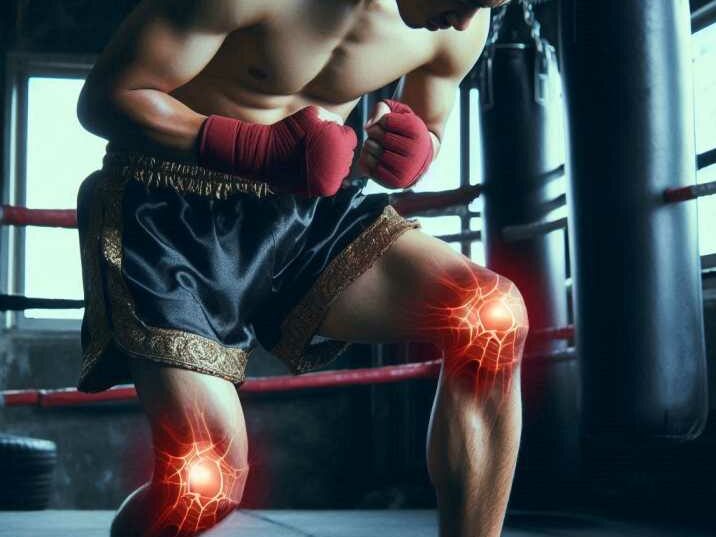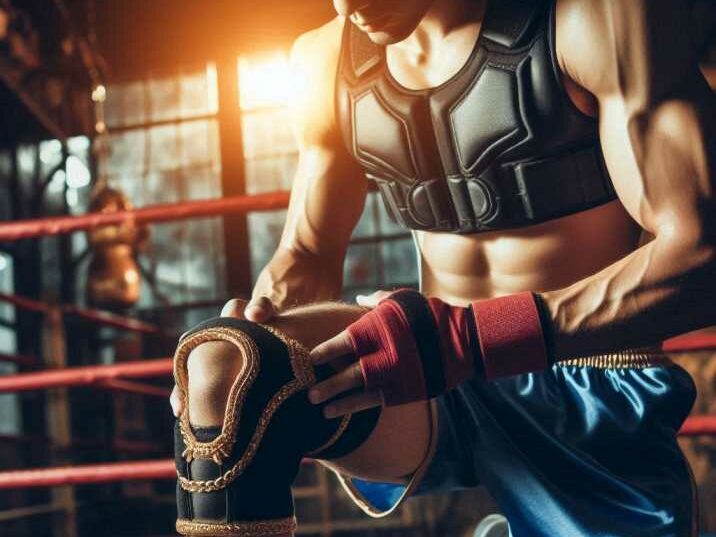Introduction
Table of Contents
Muay Thai, known as the “Art of Eight Limbs,” is a combat sport that uses stand-up striking along with various clinching techniques. It’s a physically demanding sport that requires strength, agility, and endurance. But what if you have bad knees? Can you still participate in Muay Thai without exacerbating your knee problems? In this comprehensive guide, we will explore the challenges and solutions for practicing Muay Thai with bad knees. We’ll provide expert advice, training modifications, and tips for knee care, ensuring that you can enjoy this powerful martial art safely and effectively.

Table of Contents
- Understanding Knee Problems
- The Impact of Muay Thai on Knees
- Precautions and Preparations
- Modifications for Training
- Strengthening and Rehabilitation Exercises
- Nutrition and Supplements for Knee Health
- Protective Gear and Equipment
- Success Stories: Muay Thai Practitioners with Bad Knees
- Frequently Asked Questions (FAQs)
- Conclusion
Understanding Knee Problems
Common Knee Issues
Knee problems can range from minor aches to severe injuries. Understanding the different types of knee issues is crucial for effective management and prevention. Common knee issues include:
- Osteoarthritis: A degenerative joint disease characterized by the breakdown of cartilage, leading to pain, stiffness, and reduced mobility. This condition is more common in older adults but can affect younger individuals, especially athletes.
- Meniscus Tears: These are tears in the knee’s cartilage that act as shock absorbers. Meniscus tears can occur due to sudden twists or turns, commonly experienced in high-impact sports.
- Ligament Injuries: The knee is stabilized by several ligaments, including the ACL (anterior cruciate ligament) and MCL (medial collateral ligament). Injuries to these ligaments can result from high-stress activities and lead to significant pain and instability.
- Patellar Tendinitis: Also known as jumper’s knee, this condition involves inflammation of the tendon connecting the kneecap to the shinbone. It is commonly caused by repetitive stress on the knee.
Symptoms and Diagnosis
Identifying symptoms early can help in managing knee problems effectively. Common symptoms include:
- Pain: This can range from a dull ache to sharp, debilitating pain, often exacerbated by activity.
- Swelling: Inflammation and fluid buildup can cause noticeable swelling around the knee.
- Stiffness: Reduced flexibility and difficulty in fully extending or bending the knee.
- Reduced Range of Motion: Difficulty in moving the knee through its full range of motion.
Diagnosis typically involves a combination of:
- Physical Examination: A thorough examination by a healthcare provider to assess pain points, swelling, and range of motion.
- Imaging Tests: X-rays, MRIs, or CT scans to get a detailed view of the knee’s internal structures.
- Arthroscopy: A minimally invasive procedure where a camera is inserted into the knee joint to provide a direct view of the internal damage.
The Impact of Muay Thai on Knees
High-Impact Movements
Muay Thai involves various high-impact movements such as kicks, knee strikes, and jumps. These movements require explosive power and agility, placing significant stress on the knees. The twisting and pivoting motions essential for certain techniques can further strain the knee joints, especially if underlying issues are present.
Training Intensity
The high-intensity nature of Muay Thai training can lead to overuse injuries. Training sessions often include sparring, pad work, and bag work, all of which can contribute to knee stress. Proper technique is crucial to prevent injuries, but even with good form, the repetitive nature of training can lead to cumulative wear and tear on the knees.
Precautions and Preparations
Consult with a Medical Professional
Before starting or continuing Muay Thai, especially if you have pre-existing knee issues, it’s essential to consult with a medical professional. A sports medicine specialist or physical therapist can provide an assessment and specific recommendations tailored to your knee condition. This step ensures that you can train safely and effectively without aggravating your knee problems.
Warm-Up and Stretching
A thorough warm-up and stretching routine is crucial to prepare your body for the demands of Muay Thai. Focus on dynamic stretches that target the muscles and joints involved in Muay Thai movements. Dynamic stretching helps increase blood flow, improve flexibility, and reduce the risk of injury by ensuring your muscles and joints are ready for the workout.
Proper Technique
Learning and maintaining proper technique is essential to minimize stress on the knees. Poor form can lead to unnecessary strain and potential injuries. Work with a qualified Muay Thai instructor who can guide you through the correct techniques and provide feedback to ensure you are executing movements safely.
Modifications for Training
Low-Impact Alternatives
Incorporating low-impact alternatives into your training regimen can help reduce stress on your knees while still allowing you to train effectively. For example, replace high-impact kicks with knee strikes or focus on upper body techniques. These modifications enable you to continue practicing Muay Thai without placing excessive strain on your knees.
Controlled Movements
Focus on controlled movements and avoid abrupt changes in direction. Controlled shadowboxing and technical drills can be effective for improving your skills without placing undue stress on your knees. Emphasize precision and technique over speed and power to protect your joints.
Reduced Intensity
Adjusting the intensity of your training sessions can help manage knee stress. Instead of high-intensity sparring, concentrate on pad work and partner drills that allow for more control. These activities provide a safer environment for practicing techniques and improving your skills while minimizing the risk of injury.
Strengthening and Rehabilitation Exercises
Quadriceps Strengthening
Strong quadriceps muscles help support and stabilize the knee joint. Incorporate exercises like leg presses, squats, and step-ups into your routine. These exercises target the quadriceps and help improve knee stability and strength.
Hamstring Strengthening
The hamstrings play a crucial role in knee stability. Strengthen these muscles with exercises like hamstring curls and deadlifts. Balanced strength between the quadriceps and hamstrings is important for overall knee health and function.
Core and Hip Strengthening
A strong core and hips can reduce the load on your knees. Exercises like planks, bridges, and hip thrusts target these areas and help improve overall stability and movement mechanics. Strengthening the core and hips can alleviate pressure on the knees during Muay Thai movements.
Flexibility and Mobility
Maintaining flexibility and mobility in your knees and surrounding muscles is essential for preventing injuries. Incorporate activities like yoga and foam rolling into your routine. These practices help improve flexibility, reduce muscle tension, and promote better movement patterns.
Nutrition and Supplements for Knee Health
Anti-Inflammatory Diet
An anti-inflammatory diet can help manage knee pain and promote overall joint health. Focus on foods rich in omega-3 fatty acids, antioxidants, and essential vitamins. Include foods like fatty fish, nuts, seeds, fruits, and vegetables to support your knee health.
Supplements
Consider supplements that may support joint health, such as glucosamine, chondroitin, and fish oil. These supplements can help reduce inflammation and support cartilage health. Always consult with a healthcare professional before starting any supplement regimen to ensure it is appropriate for your specific needs.
Protective Gear and Equipment
Knee Braces and Supports
Wearing knee braces or supports can provide additional stability and reduce the risk of injury during Muay Thai training. Choose a brace that offers the right level of support for your condition. Braces can help alleviate pain and provide confidence during training.

Proper Footwear
Invest in high-quality footwear that offers good arch support and cushioning. Proper shoes can help absorb shock and reduce stress on your knees. Ensure your footwear is appropriate for the surfaces you train on to further protect your joints.
Training Surface
Train on appropriate surfaces that provide some give, such as mats or padded floors. Avoid hard surfaces that can exacerbate knee pain. Training on surfaces with some cushioning can help reduce impact forces on your knees.
Success Stories: Practitioners of Muay Thai with Bad Knees
Case Study 1: John’s Journey
John, a 35-year-old Muay Thai enthusiast, was diagnosed with osteoarthritis in his knees. By following a tailored training program, incorporating strength exercises, and using knee braces, John successfully managed his condition and continued to train effectively. His story highlights the importance of individualized training and proper knee care.
Case Study 2: Lisa’s Recovery
Lisa suffered a meniscus tear but was determined to return to Muay Thai. Through dedicated rehabilitation, including physical therapy and modified training, Lisa made a full recovery and resumed her practice with caution. Her experience emphasizes the value of perseverance and proper rehabilitation.
Case Study 3: Mark’s Adaptation
Mark, a competitive fighter, experienced chronic knee pain due to patellar tendinitis. By adjusting his training intensity, focusing on low-impact drills, and using anti-inflammatory nutrition, Mark continued to compete without significant setbacks. His journey showcases the effectiveness of tailored modifications and holistic approaches to knee care.
Conclusion
Can You Do Muay Thai with Bad Knees? Muay Thai is a demanding sport, but having bad knees doesn’t mean you have to give it up. By taking the necessary precautions, making training modifications, and focusing on strengthening and rehabilitation, you can continue to enjoy Muay Thai safely. Always consult with medical professionals and listen to your body to prevent further injury. With the right approach, you can maintain a healthy and active lifestyle while practicing the art of eight limbs.
Frequently Asked Questions (FAQs)
Q. Can I start Muay Thai if I already have knee problems?
Yes, but it is essential to consult with a medical professional and follow a tailored training program to avoid exacerbating your condition.
Q. What are the best exercises to strengthen my knees for Muay Thai?
Focus on quadriceps and hamstring strengthening exercises, such as leg presses, hamstring curls, and step-ups. Core and hip strengthening exercises are also beneficial.
Q. How can I reduce knee pain during training?
Incorporate proper warm-up and stretching routines, use knee braces, and focus on low-impact alternatives and controlled movements.
Q. Are there specific techniques I should avoid in Muay Thai with bad knees?
Avoid high-impact kicks and sudden changes in direction. Focus on techniques that place less stress on your knees, such as knee strikes and upper body techniques.
Q. What should I do if I experience knee pain during training?
Stop training immediately and consult with a medical professional. Follow their recommendations, which may include rest, ice, compression, and elevation (RICE).

